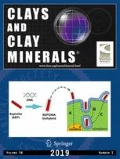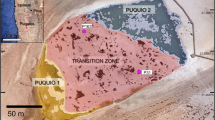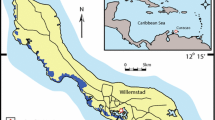Abstract
Transmission electron microscopy (TEM) has been used to demonstrate the biological formation of a hollow spherical halloysite-like mineral in freshwater systems. The interaction between clays and microbes was investigated in microbial films from laboratory cultures derived from natural sediments. Optical and electron microscopic observations of cultured microbes revealed that thin clay films covered areas of the bacterial cell wall. X-ray diffraction of the thin films after 2 y of ageing showed a 7.13 Å d spacing, consistent with a 7 Å halloysite-like phase [Al2Si2O5(OH)4 H2O]. Fourier transform infrared analysis of the thin film exhibited the characteristic adsorption bands for O−H (3651 cm−1), C−H and C−N (2925, 1454 and 1420 cm−1, respectively), suggesting that the phase was closely associated with adhesive organics. Observation by TEM of the thin films revealed that spherical, hollow, halloysite-like material formed on both coccus- and bacillus-type bacterial cells. Electron diffraction analysis of this material showed 2.9, 2.5, 2.2 and 1.5 Å d spacings. The present investigation strongly suggests that the thin film wall of the spherical halloysite-like material was associated with bacteria as a bio-organic product. This material, referred to hereafter as bio-halloysite, is further evidence for the microbially-mediated formation of clay minerals. The identity of the bacteria responsible for bio-halloysite formation is unknown, but is tentatively assigned to sulfate-reducing bacteria on the basis of morphology and the presence of reducing conditions in the microcosm at the end of the experiments.
Similar content being viewed by others
References
Asada, R. and Tazaki, K. (2000) Observation of bio-kaolinite clusters. Clay Science Japan, 40, 24–37.
Bartha, R. (1986) Biotechnology of petroleum pollutant biodégradation. Microbial Ecology, 12, 155–172.
Beveridge, T.J. (1999) Structures of gram-negative cell walls and their derived membrane vesicles. Journal of Bacteriology, 181, 4725–4733.
Bish, D.L. and Johnston, C.T. (1993) Rietveld stuctural refinement of dickite at 12 K. Clays and Clay Minerals, 41, 297–304.
Dixon, J.B. (1989) Kaolin and serpentine group minerals. Pp. 467–525 in: Minerals in Soil Environments, 2nd edition (J.B. Dixon and S.B. Weed, editors). SSSA Book Series 1, Soil Science Society of America, Madison, Wisconsin.
Ferris, F.G., Beveridge, T.G. and Fyfe, W.S. (1986) Iron-silica crystallite nucleation by bacteria in geothermal sediment. Nature, 320, 609–611.
Fialips, C.-I., Petit, S., Decarreau, A. and Beaufort, D. (2000) Influence of synthesis pH on the kaolinite crystallinity and surface properties. Clays and Clay Minerals, 48, 173–184.
Filip, Z. and Hermann, S. (2001) A attempt to differentiate Pseudomonas spp. and other soil bacteria by FT-IR spectroscopy. European Journal of Soil Biology, 37, 137–143.
Fonseca, R., Barriga, F., Fyfe, W.S. and Tazaki, K. (2000) A geological study of bottom sediments from Passo Real and Capingui reservoirs, Rio Grande do Sul, Brazil. Abstracts of the International Geological Congress, Rio, Brazil, p. 235.
Goldman, N.T. and Stoffers, P. (2002) Metastable Si-Fe phases in hydrothermal sediments of Atlantis II Deep, Red Sea. Clay Minerals, 37, 235–248.
Hanczyc, M.M., Fujikawa, S.M. and Szostak, J.W. (2003) Experimental models of primitive cellular compartments: Encapsulation, growth, and division. Science, 302, 618–622.
Holt, J.G., Krieg, N.R., Sneath, P.H.A., Staley, J.T. and Williams, S.T. (1994) Bergey’s Manual of Determinative Bacteriology, 9th edition. Williams & Wilkins, USA, 787 pp.
Kennedy, M.J., Pevear, D.R. and Hill, R.J. (2002) Mineral surface control of organic carbon in black shale. Science, 295, 657–660.
Kirkman, J.H. (1977) Possible structure of halloysite disks and cylinders observed in some New Zealand rhyolitic tephras. Clay Minerals, 12, 199–216.
Russell, M.J. (2003) The importance of being alkaline. Science, 302, 580–581.
Sara, M. and Sleytr, U.B. (2000) S-layer proteins. Journal of Bacteriology, 182, 859–868.
Shoji, S., Nanzyo, M. and Dahlgren, R.A. (1993) Volcanic Ash Soils: Genesis, Properties, and Utilization. Elsevier, Amsterdam, 288 pp.
Sudo, T. and Shimoda, S. (1978) Clays and Clay Minerals of Japan. Developments in Sedimentlogy, 26. Elsevier, Amsterdam, The Netherlands, 300 pp.
Sudo, T., Shimoda, S., Yotsumoto, H. and Aida, S. (1980) Electron Micrographs of Clay Minerals. Kodansha, Tokyo, pp. 122–125.
Tashiro, Y. and Tazaki, K. (1999) The primitive stage of microbial mats comprising iron hydroxides. Earth Science, 53, 27–35.
Tazaki, K. (1986) Observation of primitive clay precursors during microcline weathering. Contributions to Mineralogy and Petrology, 92, 86–88.
Tazaki, K. (1997) Biomineralization of layer silicates and hydrated Fe/Mn oxides in microbial mats: An electron microscopical study. Clays and Clay Minerals, 45, 203–212.
Tazaki, K. (2000) Formation of banded iron-manganese structures by natural microbial communities. Clays and Clay Minerals, 48, 511–520.
Tazaki, K. and Asada, R. (2003) Microbes associated with clay minerals; Formation of bio-halloysite. Pp. 569–576 in: 2001. A Clay Odyssey (E.A. Dominguez, G.R. Mas and F. Cravero, editors). Elsevier, Amsterdam, The Netherlands,.
Tazaki, K. and Fyfe, W.S. (1987a) Formation of primitive clay precursors on K-feldspar under extreme leaching conditions. Proceedings of the International Clay Conference, Denver, 1985, pp. 53–58.
Tazaki, K. and Fyfe, W.S. (1987b) Primitive clay precursors formed on feldspar. Canadian Journal of Earth Science, 24, 506–527.
Theng, B.K.G and Orchard, V.A. (1995) Interactions of clays with microorganisms and bacterial survival in soil: A physicochemical perspective. Pp. 123–139 in: Environmental Impact of Soil Component Interactions (P.M. Huang, J. Berthelin, J.M. Bollag, W.B. McGill and A.L. Page, editors). CRC Press, Florida.
Ueshima, M. and Tazaki, K. (1998) Bacterial bio-weathering of K-feldspar and biotite in granite. Clay Science Japan, 38, 68–82.
Ueshima, M. and Tazaki, K. (2001) Possible role of microbial polysaccharides in nontronite formation. Clays and Clay Minerals, 49, 292–299.
Ueshima, U., Mogi, K. and Tazaki, K. (2000) Microbes associated with bentonite. Clay Science Japan, 39, 171–183.
Urrutia, M.M. and Beveridge, T.J. (1993) Mechanism of silicate binding to the bacterial cell wall in Bacillus subtilis. Journal of Bacteriology, 175, 1936–1945.
Wada, K. and Kakuto, Y. (1985) Embryonic halloysites in Ecuadorian soils derived from volcanic ash. Soil Science Society of America Journal, 49, 1309–1318.
Author information
Authors and Affiliations
Corresponding author
Rights and permissions
About this article
Cite this article
Tazaki, K. Microbial Formation of a Halloysite-Like Mineral. Clays Clay Miner. 53, 224–233 (2005). https://doi.org/10.1346/CCMN.2005.0530303
Received:
Revised:
Published:
Issue Date:
DOI: https://doi.org/10.1346/CCMN.2005.0530303




